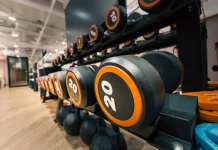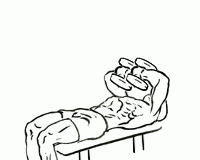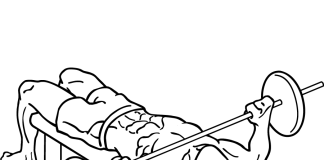Last Updated on September 30, 2022
Crunches are a tried-and-true exercise for targeting your abdominal muscles, but when you add a stability ball into the mix, you take this classic move to the next level. Crunches with legs on a stability ball offer a unique twist that not only engages your core but also challenges your balance and stability. This added instability increases the intensity of the exercise and ensures that you’re working more muscles, especially those deep core stabilizers, which are essential for overall functional movement.
In this blog, we’ll dive into the details of this exercise: how to perform it with perfect form, the benefits it offers, common mistakes to avoid, and how to modify or progress the movement based on your fitness level. Whether you’re a beginner or an experienced fitness enthusiast, this guide will help you master Crunches with Legs on a Stability Ball and maximize your core workout.
What Are Crunches with Legs on a Stability Ball?
Crunches with legs on a stability ball are a variation of the traditional crunch exercise, but with a key difference: your legs are placed on a stability ball instead of being flat on the floor. This minor adjustment increases the challenge for your core because you must now maintain balance and control throughout the entire movement.
By incorporating a stability ball into your crunches, you activate more muscles in your core, especially those that support balance and stability, such as the transverse abdominis and obliques. This exercise also helps to engage your hip flexors and lower back, making it a more comprehensive core workout.
Why Use a Stability Ball?
Stability balls, also known as Swiss balls or exercise balls, are an effective tool for adding variety and difficulty to your workouts. When you use a stability ball in your crunches, your body must continuously adjust to maintain balance. This dynamic instability forces your muscles to work harder, particularly your core, and enhances the overall effectiveness of the exercise.
Using a stability ball can improve your core strength, balance, and posture. It’s also a great way to make a familiar exercise, like crunches, more challenging without adding external weight or resistance. By combining the benefits of crunches with the added balance challenge from the ball, you’ll target your muscles in new and effective ways.
Benefits of Crunches with Legs on a Stability Ball
This exercise offers a range of benefits, especially for those looking to improve their core strength and stability. Some of the key benefits include:
- Improved Core Stability: The stability ball forces your core muscles to work harder to maintain balance, helping to improve your overall core stability. This is essential for everyday activities and athletic performance.
- Increased Muscle Engagement: By performing crunches on a stability ball, you engage more muscles than you would with a traditional crunch. Your abs, obliques, and even your lower back are activated as you stabilize yourself on the ball.
- Better Posture: A strong core helps support your spine and improves your posture. By regularly incorporating stability ball exercises into your routine, you can reduce slouching and improve your overall body alignment.
- Low-Impact Exercise: Crunches with legs on a stability ball are a low-impact exercise, meaning they’re easy on your joints. This makes them a great option for people of all fitness levels, especially those who may be recovering from an injury or looking for a gentle yet effective core workout.
- Enhanced Coordination and Balance: Balancing on the stability ball while performing crunches challenges your coordination and improves your body’s ability to stay balanced. This benefit extends beyond your workout, as better coordination can help prevent falls and injuries in daily life.
- Versatility: Stability balls are inexpensive, portable, and can be used for a wide range of exercises. Adding a stability ball to your workout routine opens up a variety of possibilities for enhancing both your strength and flexibility.
How to Perform Crunches with Legs on a Stability Ball: Step-by-Step Instructions
Now that you understand the benefits, let’s dive into how to properly perform Crunches with Legs on a Stability Ball. Proper form is essential to avoid injury and ensure that you’re getting the most out of your workout.
Step 1: Set Up Your Position
Lie flat on your back on an exercise mat. Make sure the surface is comfortable and supportive enough to protect your spine throughout the exercise. Place your feet up on a stability ball. Your knees should be bent at a 90-degree angle, and the stability ball should be positioned directly under your calves.
This starting position ensures that your core is engaged and that your lower body is supported by the ball, which will make it easier to balance throughout the exercise.
Step 2: Position Your Hands
You have two options for your hand placement:
- Option 1: Cross your arms over your chest. This is the easier of the two options and is ideal for beginners or those who may be working up to more advanced variations.
- Option 2: Place your hands lightly on either side of your head, over your ears. Avoid interlocking your fingers behind your head, as this can lead to neck strain if you start to pull on your head during the crunch.
Regardless of where you place your hands, your goal should be to engage your core, not rely on your hands or neck for assistance.
Step 3: Engage Your Core
Before you begin lifting your torso, engage your core by drawing your belly button towards your spine. This helps to activate your abs and ensures that you’re working the correct muscles throughout the movement. Keeping your core tight will also help protect your lower back and prevent arching.
Step 4: Lift Your Head, Shoulders, and Chest
With your core engaged, slowly lift your head, shoulders, and chest off the floor in one smooth motion. Your lower back should remain on the floor while your upper body curls toward your knees.
As you lift, focus on contracting your abdominal muscles. This movement is all about engaging your abs, so avoid using momentum or jerking motions to lift your torso.
Step 5: Pause and Contract Your Abs
Once you’ve lifted your upper body, pause at the top of the movement and hold the contraction in your abs. This is where your abs are working the hardest, so take a moment to really feel the engagement in your core muscles.
Holding the contraction for a second or two adds intensity to the exercise and ensures that you’re not rushing through the movement.
Step 6: Slowly Lower Back to the Starting Position
After pausing at the top, slowly lower your head, shoulders, and chest back to the starting position. Be sure to move in a controlled manner, keeping your abs engaged throughout the descent.
It’s important not to let gravity do the work here. By slowly lowering your torso, you maintain tension in your abs and get the most out of each repetition.
Step 7: Repeat
Perform the desired number of repetitions. For beginners, aim for 2-3 sets of 10-15 repetitions. As you become more comfortable with the exercise and your strength improves, you can increase the number of sets or reps.
Common Mistakes to Avoid
While Crunches with Legs on a Stability Ball are a relatively simple exercise, there are some common mistakes that can reduce their effectiveness or lead to injury. Here’s what to watch out for:
1. Pulling on Your Neck
One of the most common mistakes people make during crunches is pulling on their neck to lift their head and shoulders. This can cause neck strain and reduce the effectiveness of the exercise. Keep your hands either crossed on your chest or lightly placed by your ears, and focus on engaging your abs to lift your torso.
2. Using Momentum
Avoid using momentum to swing your upper body off the floor. The goal of this exercise is to engage your abs, so make sure your movements are slow and controlled. If you find yourself relying on momentum, slow down the movement and focus on your core.
3. Arching Your Lower Back
Your lower back should remain in contact with the floor throughout the entire movement. Arching your back can place strain on your spine and reduce the effectiveness of the exercise. Engage your core and keep your lower back flat against the floor to avoid this mistake.
4. Rushing Through the Movement
Crunches are most effective when performed slowly and with control. Rushing through the exercise not only reduces its impact but also increases your risk of injury. Take your time, focus on contracting your abs, and move deliberately through each rep.
Variations of Crunches with Legs on a Stability Ball
Once you’ve mastered the basic version of this exercise, you can try these variations to keep your workouts challenging and effective:
1. Weighted Stability Ball Crunches
Hold a weight, such as a dumbbell or weight plate, across your chest while performing the exercise. The added resistance will increase the intensity and help you build more strength in your core.
2. Bicycle Crunches on a Stability Ball
Add a twist to your crunches by incorporating a bicycle motion. As you lift your upper body, rotate your torso to bring one elbow towards the opposite knee while extending the other leg. This variation targets your obliques and adds a cardio element to the exercise.
3. Reverse Crunches with a Stability Ball
For a more intense lower ab workout, try reverse crunches with a stability ball. Instead of lifting your upper body, you’ll lift your legs and hips off the ball while keeping your upper body on the floor. This variation targets the lower abs and hip flexors.
4. Stability Ball V-Sits
This advanced variation involves balancing on the stability ball while lifting both your upper body and legs into a “V” shape. It requires strong core stability and balance, making it a great challenge for those looking to take their core workout to the next level. To perform a Stability Ball V-Sit, sit on the stability ball with your feet flat on the floor. Lean back slightly and lift your feet off the floor while extending your legs straight out in front of you. Simultaneously, lift your torso, creating a “V” shape with your body. Hold the position briefly before lowering back to the starting position. This variation not only targets your abs but also engages your hip flexors and improves your balance.
How to Incorporate Crunches with Legs on a Stability Ball Into Your Routine
Crunches with Legs on a Stability Ball can be included in your regular workout routine in a number of ways. Here are some ideas to ensure you’re making the most of this exercise and continuing to challenge your core muscles:
1. Core-Focused Workout
Include crunches with legs on a stability ball in a dedicated core workout. Pair them with other effective core exercises such as planks, Russian twists, and leg raises. This will help ensure you’re targeting every aspect of your core, from your abs to your obliques and lower back. Aim for 3-4 sets of each exercise, with 10-20 reps per set.
2. Add to Full-Body Workouts
Integrate crunches with legs on a stability ball into your full-body workout routine. Since this exercise focuses on the core, it can be a great addition to workouts that include strength training for the arms, legs, and back. Perform 2-3 sets of crunches at the end of your workout to give your abs an extra burn.
3. Superset with Cardio
For an intense workout, alternate between crunches with legs on a stability ball and cardio exercises such as jumping jacks or mountain climbers. This combination will help you burn calories while building core strength. For example, perform 30 seconds of crunches followed by 30 seconds of high-intensity cardio, repeating for several rounds.
4. Recovery Day Core Training
If you’re having a recovery or low-impact day, crunches with legs on a stability ball are a great way to keep your core engaged without putting too much stress on your body. Since the stability ball adds a level of support, it’s an ideal exercise for low-impact workouts that still challenge your core.
Progression Tips for Advanced Users
Once you’ve become comfortable with Crunches with Legs on a Stability Ball, it’s important to continue progressing in your workouts to avoid plateaus. Here are some ways to keep challenging yourself:
1. Increase Reps and Sets
If you’re performing 10-15 reps per set, try increasing that number to 20-25 reps. As your core becomes stronger, you can also add more sets to your routine, gradually working up to 4-5 sets per exercise.
2. Add Resistance
As mentioned earlier, holding a weight plate or dumbbell across your chest during the crunch can increase the difficulty of the exercise. If you don’t have weights available, you can use household items like water bottles or even a resistance band to create extra tension.
3. Try Stability Ball Rollouts
For an added challenge, incorporate Stability Ball Rollouts into your routine. Kneel on a mat and place your forearms on the stability ball. Roll the ball forward as far as you can while maintaining a neutral spine and engaged core, then roll it back to the starting position. This advanced move will engage your entire core and improve your balance and stability.
4. Mix in Other Core-Stabilizing Exercises
Don’t limit yourself to crunches! To fully develop a strong and functional core, incorporate other core-stabilizing exercises like planks, Russian twists, and hanging leg raises. These moves will complement the work you’re doing with the stability ball and help you avoid muscle imbalances.
Crunches with Legs on a Stability Ball for Different Fitness Levels
Whether you’re just starting your fitness journey or you’re a seasoned athlete, Crunches with Legs on a Stability Ball can be tailored to your fitness level.
1. For Beginners
If you’re new to this exercise, start by performing 2-3 sets of 10-12 reps, focusing on perfect form. Keep your movements slow and controlled, and take breaks as needed. As you become more comfortable with the exercise, gradually increase the number of reps and sets.
2. For Intermediate Users
Once you’ve mastered the basic version of this exercise, you can begin adding more challenging variations to your routine. Try incorporating weighted crunches, reverse crunches, or adding a stability ball rollout at the end of each set. Aim for 3-4 sets of 15-20 reps, and focus on maintaining control throughout the movement.
3. For Advanced Users
Advanced users can add additional resistance, increase their reps and sets, or combine multiple variations into a single workout. For example, you might perform 3 sets of 10 weighted crunches, followed by 3 sets of reverse crunches with the ball, and finish with 2 sets of stability ball rollouts. This combination will challenge even the most experienced fitness enthusiasts.
Safety Considerations
Like any exercise, Crunches with Legs on a Stability Ball should be performed with care to avoid injury. Here are a few safety tips to keep in mind:
1. Warm Up
Always warm up your body before engaging in any exercise. A proper warm-up will increase blood flow to your muscles and reduce the risk of injury. Consider doing 5-10 minutes of light cardio, followed by dynamic stretches that target your core, such as torso twists and cat-cow stretches.
2. Focus on Form
Maintaining proper form is key to avoiding injury and ensuring that you’re getting the most out of your workout. Keep your movements controlled and avoid jerking motions. If you’re unsure about your form, consider working with a fitness trainer or using a mirror to check your alignment.
3. Engage Your Core
Always keep your core engaged throughout the exercise to protect your spine and avoid arching your lower back. If you feel discomfort in your lower back, pause the exercise and check your form. Make sure your lower back remains pressed into the floor and that your movements are smooth and controlled.
4. Use the Right Size Stability Ball
Choosing the correct size stability ball is important for maintaining balance and control during the exercise. A general rule of thumb is that when you sit on the ball, your knees should be at a 90-degree angle. If the ball is too large or too small, it can affect your ability to perform the exercise safely and effectively.
5. Cool Down and Stretch
After completing your workout, take a few minutes to cool down and stretch. Stretching helps to improve flexibility, reduce muscle soreness, and enhance recovery. Focus on stretches that target your core, such as the cobra stretch, child’s pose, and side stretches.
Final Thoughts on Crunches with Legs on a Stability Ball
Crunches with Legs on a Stability Ball are an excellent way to challenge your core, improve your balance, and add variety to your workout routine. By performing this exercise correctly and incorporating variations, you’ll be able to target different parts of your core, build strength, and enhance your stability. Whether you’re a beginner or an advanced athlete, this exercise offers a low-impact yet effective way to build a strong and toned core.
Remember to focus on proper form, engage your core muscles throughout the movement, and take your time with each repetition. As you become more confident with the exercise, you can increase the difficulty by adding weights, increasing reps, or incorporating more advanced variations.
Incorporate Crunches with Legs on a Stability Ball into your routine and see how this dynamic exercise can transform your core strength and stability. Keep challenging yourself, and soon you’ll notice a stronger, more balanced body!








